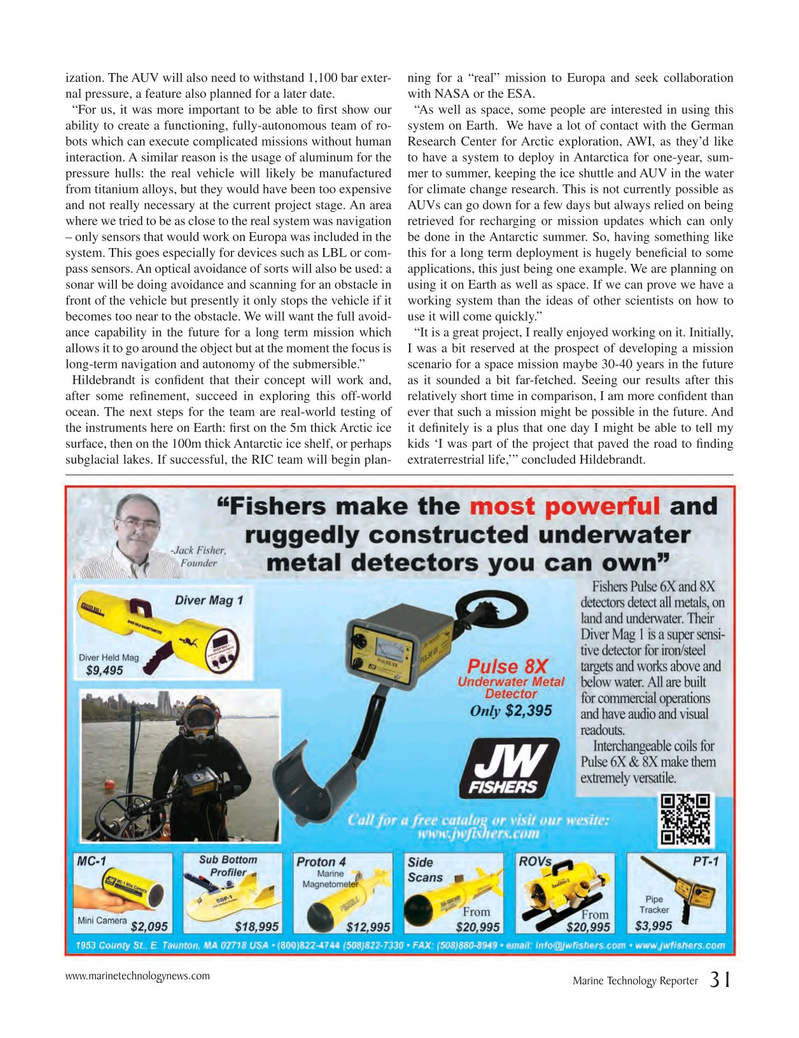
Page 31: of Marine Technology Magazine (October 2016)
AUV Operations
Read this page in Pdf, Flash or Html5 edition of October 2016 Marine Technology Magazine
ization. The AUV will also need to withstand 1,100 bar exter- ning for a “real” mission to Europa and seek collaboration nal pressure, a feature also planned for a later date. with NASA or the ESA. “For us, it was more important to be able to ? rst show our “As well as space, some people are interested in using this ability to create a functioning, fully-autonomous team of ro- system on Earth. We have a lot of contact with the German bots which can execute complicated missions without human Research Center for Arctic exploration, AWI, as they’d like interaction. A similar reason is the usage of aluminum for the to have a system to deploy in Antarctica for one-year, sum- pressure hulls: the real vehicle will likely be manufactured mer to summer, keeping the ice shuttle and AUV in the water from titanium alloys, but they would have been too expensive for climate change research. This is not currently possible as and not really necessary at the current project stage. An area AUVs can go down for a few days but always relied on being where we tried to be as close to the real system was navigation retrieved for recharging or mission updates which can only – only sensors that would work on Europa was included in the be done in the Antarctic summer. So, having something like system. This goes especially for devices such as LBL or com- this for a long term deployment is hugely bene? cial to some pass sensors. An optical avoidance of sorts will also be used: a applications, this just being one example. We are planning on sonar will be doing avoidance and scanning for an obstacle in using it on Earth as well as space. If we can prove we have a front of the vehicle but presently it only stops the vehicle if it working system than the ideas of other scientists on how to becomes too near to the obstacle. We will want the full avoid- use it will come quickly.” ance capability in the future for a long term mission which “It is a great project, I really enjoyed working on it. Initially, allows it to go around the object but at the moment the focus is I was a bit reserved at the prospect of developing a mission long-term navigation and autonomy of the submersible.” scenario for a space mission maybe 30-40 years in the future
Hildebrandt is con? dent that their concept will work and, as it sounded a bit far-fetched. Seeing our results after this after some re? nement, succeed in exploring this off-world relatively short time in comparison, I am more con? dent than ocean. The next steps for the team are real-world testing of ever that such a mission might be possible in the future. And the instruments here on Earth: ? rst on the 5m thick Arctic ice it de? nitely is a plus that one day I might be able to tell my surface, then on the 100m thick Antarctic ice shelf, or perhaps kids ‘I was part of the project that paved the road to ? nding subglacial lakes. If successful, the RIC team will begin plan- extraterrestrial life,’” concluded Hildebrandt.
www.marinetechnologynews.com
Marine Technology Reporter 31
MTR #8 (18-33).indd 31 9/27/2016 2:02:44 PM

 30
30

 32
32
